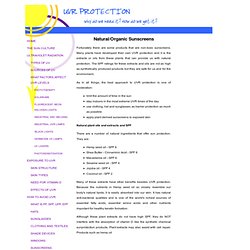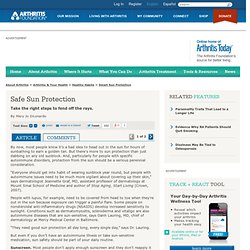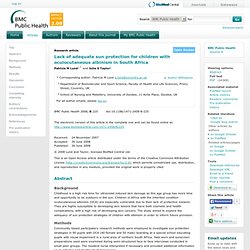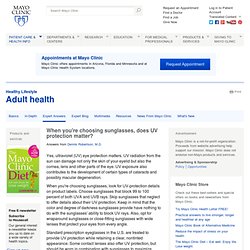

Natural skin care. N-S Ingredients. Clothing, Sun Hats, UV Protection Swimwear - Cool. Sun protection for children, sunscreens. The importance of protecting ourselves and families from the sun is becoming more widely understood and appreciated and the possible dangers involved are now appreciated, particularly where children are involved.

With this in mind, you may find the following very general information of interest although we would always recommend that you seek professional advice in order to ensure you are taking the correct precautions for your particular circumstances. Sunscreens Can sunscreens be used on babies and young children? We have no evidence to suggest that sunscreens are harmful to young children when used in small amounts on the face and hands. Their skin, however, is more likely than an adult's to absorb the ingredients in the sunscreens, and the rest of their body is best protected with clothing* rather than sunscreen. What do SPF numbers mean? SPF stands for Sun Protection Factor, and is a laboratory measure, which grades the ability of a sunscreen to filter out UVB rays. Natural sun protection from plant oils.
Natural/Organic Sunscreens. Fortunately there are some products that are non-toxic sunscreens.

Many plants have developed their own UVR protection and it is the extracts or oils from these plants that can provide us with natural protection. The SPF ratings for these extracts and oils are not as high as synthetically produced products but they are safe for us and for the environment. As in all things, the best approach to UVR protection is one of moderation: limit the amount of time in the sun stay indoors in the most extreme UVR times of the day use clothing, hat and sunglasses as barrier protection as much as possible apply plant derived sunscreens to exposed skin.
Understanding Sun Protection Clothing: Expert Advice from REI. Autoimmune Sun Safety. By now, most people know it’s a bad idea to head out in the sun for hours of sunbathing to earn a golden tan.

But there’s more to sun protection than just dabbing on any old sunblock. And, particularly for people with specific autoimmune disorders, protection from the sun should be a serious perennial consideration. “Everyone should get into habit of wearing sunblock year round, but people with autoimmune issues need to be much more vigilant about covering up their skin,” says dermatologist Jeannette Graf, MD, assistant professor of dermatology at Mount Sinai School of Medicine and author of Stop Aging, Start Living (Crown, 2007).
People with lupus, for example, need to be covered from head to toe when they’re out in the sun because exposure can trigger a painful flare. Some people on nonsteroidal anti-inflammatory drugs (NSAIDS) develop increased sensitivity to sunlight. “They need good sun protection all day long, every single day,” says Dr. Sunscreen. Clothes. Kabana Skin Care Ingredients Precisely Natural Simple Seven Shea. Lack of adequate sun protection for. This CBPR follow-up investigation into sun protection strategies found that: • Pupils possessed sufficient hats, but the brim widths were largely insufficient to protect the lower face and neck; • Sun exposure was particularly acute during leisure activities, and there is a balance to be found between sun protection and 'normal' childhood activity; • Whilst children were aware of the need to use sunscreen lotions, they did not understand the term SPF; • Application of sunscreen lotions was sporadic; • There was an insufficient supply of sunscreen lotions; • Cost and access to sunscreen lotions was prohibitive; • There was little accessible dermatological support.

Although the daily school routine was organised to minimise sun exposure it was more difficult to curtail pupils' exposure during their free recreational time, particularly over the week-ends and during school holidays when pupils returned home, often to rural villages. Wearing a hat is a simple photoprotective measure. Suncare from Alexa Spa.
Tanning Tips. Eye Protection.

Ultraviolet tanning rays (UVA and UVB) are harmful to your eyes. Eyelids are too thin to provide adequate protection against injury. FDA approved goggles are available for purchase and must be worn. Frequency. Allow a minimum of 24 hours between tanning sessions. Tanning Plateau. Clean skin. Moisturizing. Tanning Accelerators. Since these products are comprised of many essential vitamins, extreme temperatures can cause them to lose their effectiveness. Outdoor Lotions and Oils. Nude Tanning. Medications. Choosing sunglasses: Is UV protection important? - MayoClinic.co. Yes, ultraviolet (UV) eye protection matters.

UV radiation from the sun can damage not only the skin of your eyelid but also the cornea, lens and other parts of the eye. UV exposure also contributes to the development of certain types of cataracts and possibly macular degeneration. When you're choosing sunglasses, look for UV-protection details on product labels.